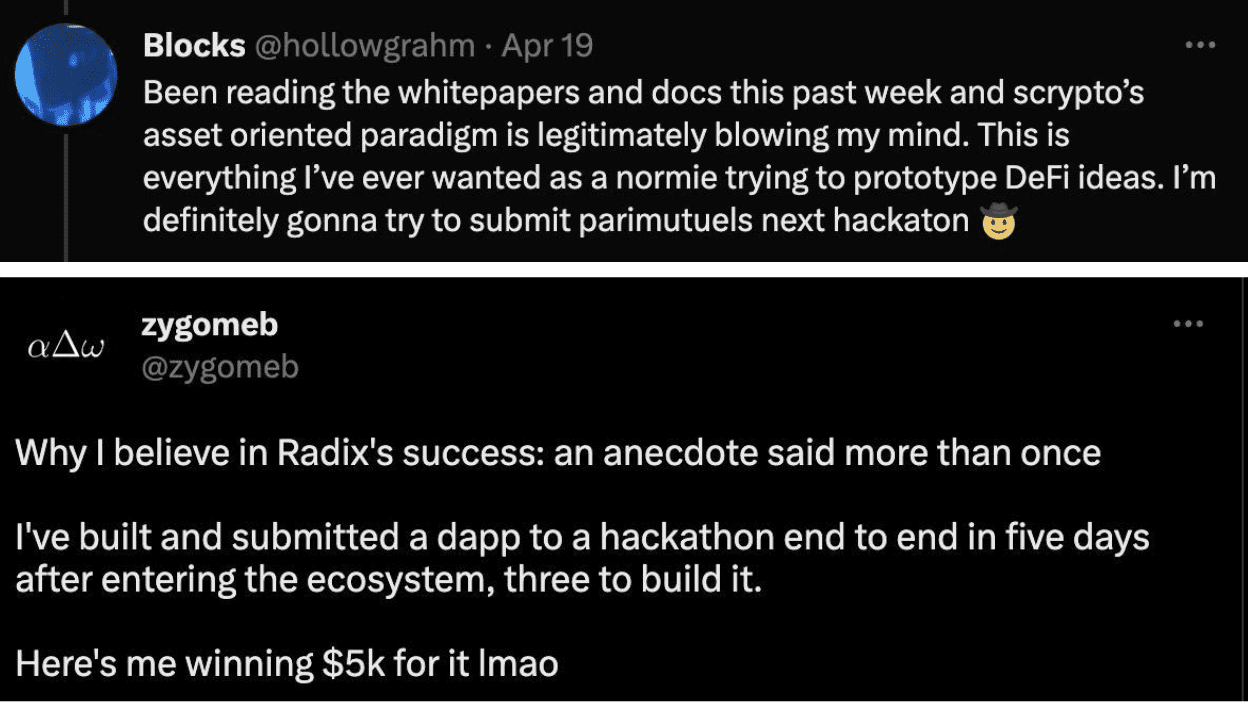One of the oldest projects in the crypto-world, Radix is turning 10 next month. We sat down with its CEO Piers Ridyard and talked about the new opportunities, threads and challenges of crypto-industry, and discussed the evolution of one of the oldest blockchain ecosystems.
TB: Please tell us a little more about yourself.
Piers Ridyard: I started in crypto when I started mining on the genesis block of Ethereum in early 2015, investing in “The DAO” and going deep on everything from game theory to prediction markets. This eventually led me to build and exit Surematics, a YCombinator company that built decentralized dealroom software for insurance companies in 2017.
I became CEO of RDX Works in 201, joining the Founder, Dan Hughes, and building the team to over 75 people around the world.
My background includes finance, law, electronics, and mathematics.I also have two degrees, one in Chinese and Business and a second in Law, as well as having achieved his level 1 Chartered Financial Analyst designation.
TB: What is Radix, and what unique solutions do you bring to the blockchain market?
Piers Ridyard: Like Ethereum, Radix is a layer 1 smart contract platform, although Radix is as different to Ethereum as a jumbo jet is to a biplane.
In a nutshell, Radix is the base layer upon which any developer can build dApps (decentralized applications) on top of. End users can use those dApps for services such as payments, borrowing, trading, or lending for any form of a digital asset such as tokens or NFTs. You can also use Radix for passwordless login to any app or website that supports it without relying on any centralized service to hold your data.
The Radix project is one of the origins of the crypto industry: it’ll be 10 years next month. The reason it’s taken this long is that we had an end goal in mind and worked backwards from that objective. That objective is to build a decentralized ledger capable of supporting mainstream-ready experiences for users, developers, and capital at the scale of the global financial system.
That has meant designing, then redesigning, and redesigning again the Radix technology stack. We finally cracked the architecture in 2020, and now after three years of heavy building, our next major release, the Babylon mainnet upgrade, is ready to go live in July. Babylon brings our solution to user experience with the Radix Wallet, and developer experience with our Scrypto programming language and Radix Engine application environment.
If you want to draw a parallel to another product that focused relentlessly on providing the best possible experience by tightly integrating a custom “full stack” of technologies, we can compare Radix to when the iPhone was launched in 2007:
Both are platforms for others to build an ecosystem of products, services, and businesses on top of. Both take a tightly integrated full stack approach to providing the best possible experiences for developers and end users, without compromise. Apple did this with its own custom hardware, iOS, and App Store; Radix does this with its own custom consensus, application environment, programming language, and wallet.
Only with each layer of the stack being carefully thought through and fully optimized can you deliver the best possible experience. And the experience for today’s Web3 is, to put it mildly, pretty borked. Don’t believe me? Just take a look at this website (http://rekt.news) documenting various different DeFi hacks over the last few years. It’s totally unacceptable for billions of dollars to be lost if we ever want Web3 and DeFi to be trusted and safe enough for mass adoption.
If we zoom in on some examples of what the Web3 experience is like today, here are just three fiddly practices that Web3 users are now dangerously accustomed to:
1) writing down a “seed phrase”, which is like a master password to all your assets that if it gets lost or stolen, so do all your tokens;
2) “approving” dApps to spend all your tokens even if you just want to exchange a small amount. If the dApp has a single bug, then the user’s funds could be stolen;
3) “blind signing” transactions, which is how nearly every transaction on Ethereum is signed today, and is the Web3 equivalent of writing a blank check without any guarantees that the transaction will do what you asked it to do.
The above problems can’t be easily fixed in just the wallet alone. Just how it took a full stack solution to take the user experience for smart phones into the mainstream era, Radix is taking a full stack approach to the Web3 and DeFi experience, fixing all three of these example issues with “Smart Accounts”, “Native Tokens”, and the “Transaction Manifest” respectively. These solutions are going live in 3 months with the Radix Babylon mainnet upgrade.
If you’d like to see the wallet in action, definitely check out the wallet demo from our “RadFi” keynote in December.
TB: How does Radix connect developers, dApps, wallets, exchanges and businesses to blockchains? Could you give us a walkthrough of the Radix technology and how it works?
Piers Ridyard: Interesting question. So, Radix is really just software that anyone can run on their computer. When a computer runs that software and connects to others running that software, it forms a network, and we call those computers nodes.
Those nodes, in turn, then agree with one another on the state of the Radix Ledger, which is an immutable record of transactions.
The Radix Ledger can hold any kind of data: whether it’s who won a sports game for a decentralized prediction application, a record of who owns a token, or the smart contract logic that forms the basis of a dApp.
The Radix Ledger is where developers deploy their dApps, such as a decentralized exchange, which would allow users to exchange tokens in a peer-to-peer manner. The ledger is where business owners can leverage NFT dApps for things like concert tickets or reward points at a fraction of the cost of Web2 equivalents, and allow users to easily exchange tickets if they can no longer make it to the gig. It’s the ledger that a wallet connects to to allow users to query their accounts and submit transactions. The ledger is where it’s at. Everything connects to it. All other parts of the Radix stack either just support the ledger, or provide a window into it.
Ultimately this is why Radix is called Radix DLT, which stands for Distributed Ledger Technology. Also, Radix is not a blockchain, as 7 years of research into scalability led us to conclude that blocks are a barrier to scaling. Instead, you can think of Radix as a chain of transactions, not blocks.
TB: Could you give us some insights into your recent partnerships with LayerZero Labs, and how this benefits Web2 companies?
Piers Ridyard: Like any new industry with lots of potential, Web3 has thousands of really smart people trying many new architectures and solutions. This has given rise to hundreds of different networks each with their own unique applications, use cases, advantages, and disadvantages. What our partnership with LayerZero does is it opens up the Radix network to be able to communicate with 25 of those other networks today, and many more tomorrow.
In practical terms, this means that dApps built on Radix can send messages to dApps built on any of those other networks, and vice versa. This will allow for trustless swapping or minting of assets across networks. It will allow for dApps with a presence on multiple different networks to leverage Radix’s unique user experience features, while behind the scenes execute transactions and leverage the liquidity on any of those other networks.
LayerZero will allow Web2 companies who dip their toes in Web3 to get the best of all worlds, cherry-picking the unique features and dApps from each of the connected networks, and present this in an experience where the end user may not even be aware that they are transacting with multiple different networks under the hood.
If you’d like to really delve into this, I recommend you read an opinion piece I wrote last month titled: The Winning Duo for Web3.
TB: Can you explain the concept of Web3 and its relevance to Radix, how is Web3 influencing the tech industry, and what impact is it making in people’s lives?
Piers Ridyard: So Web3 is one of these often misunderstood terms.
One of my favorite encapsulations of the term is that where Web1 is read (static websites); Web2 is write (social media); Web3 is own.
Public decentralized ledgers (such as a blockchain) allow anyone to own digital tokens on the internet, such as the governance token for a DAO, through to an NFT that represents ownership of real estate.
These ledgers also allow anyone to own their own identity. No longer do you need a password, or need to rely on Web2 giants such as Google or Apple to hold passkeys for you; instead you can achieve a passwordless future without relying on any intermediary through use of cryptography.
That’s pretty much all that Web3 means. A new suite of products and services on the internet that allow users to own digital assets and their identity online.
TB: How can blockchain systems help disrupt intermediaries and gatekeepers in various industries, could you give us some use cases and a market overview of this disruption?
Piers Ridyard: Blockchain systems, or public decentralized ledgers, are in essence a shared computing environment. The nodes that I mentioned above agree with one another on the state of a common ledger.
This is really powerful as instead of relying on one entity, such as a big tech company or bank to be the arbiter of truth, everyone can transact with one another and rely on just pure computer logic running autonomously and agreed by many different computers. In terms of innovation, as anyone can contribute to the whole by building their own dApp, this will allow for much more choice, competition, and innovation, than equivalent products and services where we are reliant on a few large incumbents.
For a few examples of the benefits; with Web3 content creators can share content, build their own communities, and fund themselves knowing they won’t be deplatformed; anyone can set up an international business knowing that a bank won’t be taking exorbitantly high fees; and anyone can set up an investment account even if they have only $10 to invest.
We think the biggest area where this will have an impact is finance. Finance is the largest industry in the world in terms of just pure dollar amounts with approximately $400 trillion of assets under management.
Compare that to the $50 billion managed by DeFi (decentralized finance) today, and we’re talking something along the lines of DeFi having captured only 0.01% of its total addressable market to date.
There are huge opportunities available for those that are willing to build or invest in the products and services that will grow DeFi into meaningful percentages of that total.
I’ll leave you with an analogy. In the 1990s people were stuck with just a few TV channels or cable TV. We could only watch what the big corporations decided for us. Contrast that to YouTube today, where anyone can upload their own videos on any topic. Yes, the majority of videos aren’t good. But there are so many, that those that are good are fantastic, and tailored specifically to what you like. This is what an open platform means for quality and choice. And we think the open platform of DeFi will do the same to finance as YouTube did to TV.
TB: What are your plans to grow the Radix ecosystem? What are some other examples of successful partnerships that Radix has formed with other companies working in the Web3 space, do you have more opportunities for partnerships or investors?
Piers Ridyard: Radix is relentlessly focused on delivering the best possible experience for users and developers. While partnerships are nice, each deal takes a lot of bespoke time and effort, and ultimately that’s not scalable. Instead our priority is to grow the most enthusiastic and capable grassroots developer community in Web3. They come because it’s the best place to build your future Web3 business or dApp.
That means creating a safe and intuitive programming language, Scrypto. And then supporting the community in building dApps through public support channels, courses such as Scrypto 101, hackathons, the Radix Grants Program, and the sustainable automated developer royalties system.
We’re already seeing fantastic feedback from developers, such as two new devs in the ecosystem below:
And this community member who didn’t know how to code last summer, recreated the functionality of a complex DeFi dApp in just 5 weeks.
With this kind of developer experience, we’ve already seen over 9,500 developers try Scrypto since it launched in early access form in December 2021. And 50+ projects are currently building in the Radix ecosystem.
Case in point, even before smart contracts go live, we have applications that you can use today on the Radix platform such as exchanges like Ociswap or CaviarSwap, or NFT marketplaces such as Vikingland. These applications are currently leveraging Radix’s native assets, but the application logic is executing off-chain. Once smart contracts go live as part of Babylon, then this logic can be brought on-chain and be fully decentralized.
Yes, we will have more strategic partnerships to come. But the most important thing for any ecosystem are its developers. And their enthusiasm for building on Radix is one of the things that we’re most excited about.
TB: What are you currently working on at Radix and what is next on your roadmap?
Piers Ridyard: All eyes are on the upcoming Babylon mainnet upgrade that is scheduled for 31 July 2023.
Babylon brings with it the Radix Wallet that will massively improve Web3 and DeFi user experience. Babylon also allows developers to deploy their smart contracts written in Scrypto to the Radix mainnet for the first time, bringing the full-suite of powerful Web3 and DeFi smart contract functionality to Radix.
Following Babylon we will then start looking into specifying the Xi’an mainnet upgrade, which is focused on scalability, and will shard the Radix Ledger into a practically infinite number of shards (2^256 for those that are into big numbers).
The Xi’an upgrade will then allow the Radix ledger to scale throughput linearly. In other words, as more nodes join the network to process transactions, the total throughput of the Radix ledger can increase by the same amount.
What’s magic about the Radix approach to this is that our special type of scaling retains the interconnectedness of the Radix Ledger. The technical term for this is atomic composability, but it’s really important if you want to scale a ledger without fracturing your dApps or liquidity, and providing the best possible experience for users and developers.
TB: Do you have more information to share with our readers today?
Piers Ridyard: We’re all really looking forward to our Babylon launch in July, but in the mean time if you’re in Austin, Texas, for Consensus during the last week of April 2023. We have a booth and would love to meet you in person so please do swing by.
If you’d like to learn more about Radix be sure to watch our RadFi keynote, or join the Radix community in Telegram or Discord.






































